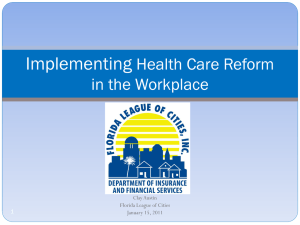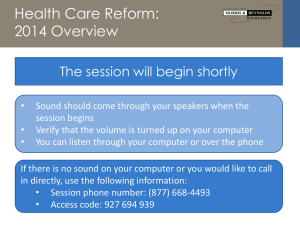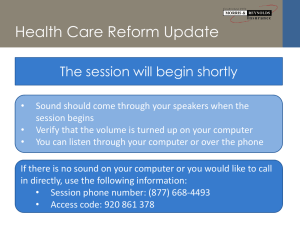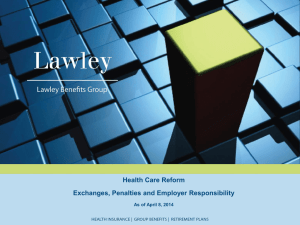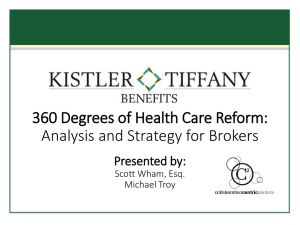Healthcare Reform - Large Groups (ppt file)
advertisement
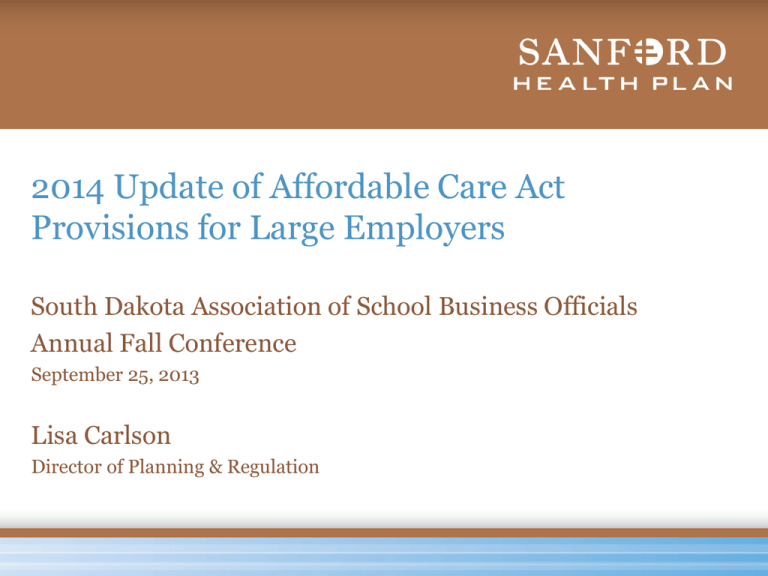
2014 Update of Affordable Care Act Provisions for Large Employers South Dakota Association of School Business Officials Annual Fall Conference September 25, 2013 Lisa Carlson Director of Planning & Regulation Impact on Large Employers Large employer = 50+ employees Large employers do not have to offer essential health benefits Large employers do not have to offer metal level plans Large employers do not have to follow rating reform rules (per member rating) • However, you must comply with new MOOP requirements • • • • Limiting Maximum Out-Of-Pocket… Maximum Out-Of-Pocket (MOOP) – For 2014, the annual cost-sharing limits cannot exceed $6,350 for an individual and $12,700 for families. This includes deductible, coinsurance, medical and pharmacy copay amounts. MOOP Tips: - Applies to non-grandfathered individual, small group and large group markets beginning in 2014 - Out-of-network services do not count towards deductible caps or MOOP - All cost sharing does apply towards MOOP, including medical and pharmacy copays - Medical and pharmacy copay amounts apply towards MOOP, but they do not apply towards the deductible caps Impact on Large Employers • Large employers are able to continue to experience variety and flexibility of plans offered today • However, in 2015 you must offer “affordable” coverage in 2015 Large Group What does “affordable access” to insurance mean? • Do you have employees whose cost for self-only coverage under the lowest cost option plan exceeds 9.5% of the employee’s income as reported on their W-2, Box 1 or rate of pay? • If yes, then they are eligible for subsidies in the Marketplace • These employees will also trigger the “penalty” for you in 2015. • Remember, as a large employer, you must offer coverage to dependent children, but are not required to offer coverage to spouses. • You can vary contribution levels by class of business… • But be aware of non-discrimination rules Non-Discrimination against highly compensated employees Health Care Reform Act Non-Discrimination Rules • Internal Revenue Code (IRC) §105(h): – Rules likely to be similar to the current rules contained in IRC §105(h)(3) – for self-funded plans • “Highly Compensated Individual” (HCIs) Defined in IRC §105(h)(5) • “Highly Compensated Individuals” (HCIs), include the highest paid 25% of all employees – Note: Schools may have more than 25 HCI employees Health Care Reform Act Non-Discrimination Rules Penalties for Plans that Fail to Comply • Excise tax for non-compliance – $100 per day per each non-highly compensated individual • The excise tax does not apply to school districts. However, schools are subject to civil penalties imposed by governmental agencies. – Civil penalties are at the discretion of the enforcing agency up to an amount of the excise tax. • Districts can be subject to civil actions (lawsuits) brought against the district by employees. Health Care Reform Act Non-Discrimination Rules • Compliance will not be required until after regulations have been issued. And, employers will be provided with a grace period to implement the regulations once issued. (IRS Notice 2011-1) • Additional guidance and regulations are expected in 2013. Health Care Reform Act Non-Discrimination Rules Current Non-Discrimination Rules • General Requirements – The plan does not discriminate in favor of highly compensated as to eligibility; • Benefit plans do not discriminate in favor of highly compensated in regard to benefits • All Group Health plans must comply – Governmental Plans – Church Plans • Some Employees can be Excluded from Testing – Not completed three years of service – Under the age of 25 Health Care Reform Act Non-Discrimination Rules Eligibility Test • Code § 105(h)(3) provides three ways to pass the Eligibility Test 1. The 70% Test 2. The 70%/80% Test 3. The Classification Test Health Care Reform Act Non-Discrimination Rules Eligibility Test • The 70% Test – Does the plan benefit 70% or more of all non-excludable employees? • The 70%/80% Test – Are 70% or more of all non-excludable employees eligible to benefit from the plan? – Do 80% or more of all non-excludable employees who are eligible participate in the plan? Health Care Reform Act Non-Discrimination Rules Eligibility - Classification Test • The plan does not discriminate in favor of HCIs under classifications set up by the employer – Code §105(h) is unclear on the applicable regulations for the Classification Test – Reasonable methods include: • Post-Tax Reform Act of 1986 (TRA) Nondiscriminatory Classification Test in Code §410(b) (includes a safe harbor and unsafe harbor test which are mathematical ratio tests), or • Fair Cross Section Test Pre-TRA (subjective test) Health Care Reform Act Non-Discrimination Rules The Benefits Test • The Benefits Test determines if non-HCIs are discriminated against in terms of being offered the same benefits, conditions, options and waiting periods • Unlike the Eligibility Test, the Benefits Test is not mathematical – it is subjective in its approach • Looks at discrimination on the face of the plan and in the operation of the plan Health Care Reform Act Non-Discrimination Rules The Benefits Test • Review all Plan Components • Contributions must be identical for each benefit level – Specifically prohibited is contribution levels based on a participant’s age, compensation or years of service • Same types of benefits must be available to HCIs and non-HCIs • Cannot impose disparate waiting periods • No discrimination in the operation of the plan Health Care Reform Act Non-Discrimination Rules The Benefits Test • Review all Plan Components • Contributions must be identical for each benefit level – Specifically prohibited is contribution levels based on a participant’s age, compensation or years of service • Same types of benefits must be available to HCIs and non-HCIs • Cannot impose disparate waiting periods • No discrimination in the operation of the plan Health Care Reform Act Non-Discrimination Rules • Contact your legal advisor, or an attorney for guidance • Most likely need to provide a census for analysis • Prepare a compliance plan If you’re a large employer, stay with me you must start measuring and counting employees hours in 2014… Large Employer Status Definitions: For shared-responsibility purposes… • • Full-time employee is anyone who works on average at least 30 hours per week OR 130 hours per month on average Variable hour employee means it cannot be determined that the employee is reasonably expected to work an average of 30 hours a week when hired: • Seasonal employee includes employees who work for 120 days or less during a calendar year. • Part time employees who work less than 30 hours per week on average Large Employer Status Definitions: For shared-responsibility purposes… Defined time periods. The safe harbors allow employers to use these time periods to predict whether an employee will qualify as full-time for sharedresponsibility purposes: • Measurement period. Employers select a fixed 3- to 12-month measurement period for determining whether an employee has averaged at least 30 hours of service per week. • Must begin by at least July 1, 2013. • You can use different measurement periods for: union vs. non; different union contracts; salaried vs. hours, in-state vs. out-of-state employees • You won’t get penalized if one of your employees gets coverage on exchange during the initial measurement period. Large Employer Status Definitions: For shared-responsibility purposes… • • Stability period. After meeting the minimum-hours threshold during the measurement period, employees must be treated as full-time – regardless of actual hours worked – during a subsequent “stability period,” provided they remain employed. • Stability period cannot be longer than measurement period plus 1 month • Stability period must be the same length for new and ongoing employees AND be the longer of: 6 months; or The length of the initial measurement period. Longer measurement period = more certainty, but it also commits you to offer insurance for a longer period of time to those employees identified as full-time. Large Employer Status Measurement Periods: • • • Optional administrative period. Employers may need time after the measurement period ends to decide which employees must be offered coverage during the ensuing stability period. The safe harbor allows an optional “administrative period” between the measurement and stability periods so employers can notify employees qualifying for coverage and handle enrollment tasks. The administrative period can’t exceed 90 days or be applied in a way that imposes a gap in employees’ coverage. Large Employer Status Safe harbor for Ongoing Employees Large Employer Status Measurement Periods: • • • • Employees who fail to meet the minimum-hours threshold during the measurement period do not have full-time status during the stability period and hence do not have to be offered health insurance during this time, and they will not trigger shared-responsibility penalties if they get insurance on the exchange. The stability period can’t be shorter in duration (number of months) than its associated prior measurement period. If an employee meets the minimum-hours threshold during the measurement period, then the ensuing stability period for coverage availability must last at least six full, consecutive calendar months. If the employee did not meet the minimum-hours threshold, the stability period cannot be longer than the measurement period. Large Employer Status Special rules for educational employers • Employees returning from breaks. Educational employers could use one of two averaging methods for employees treated as continuously employed (rather than terminated and rehired) after an “employment break period.” • An employment break period is a period of at least four consecutive weeks (disregarding unpaid FMLA, military service or jury duty leave) during which an employee has no hours of service. Large Employer Status Special rules for educational employers An educational employer may either: 1. Determine the employee’s average hours of service per week during the measurement period after excluding the employment break period, and use that average for the entire measurement period 2. Credit employees with hours of service for the employment break period at a rate equal to the employee’s average weekly rate during the weeks that weren’t part of an employment break period. Should you “Play” or “Pay” Should you Play-or-Pay? Large Employer Penalties • No Offer (Sledgehammer) This penalty is triggered if you do not offer coverage of any kind to your full-time employees and their dependents. • Under Offer (Tack Hammer) This penalty is triggered if you do offer coverage but the coverage offered does not provide either "affordable” or “minimum essential coverage” Should you Play-or-Pay? How to avoid Large Employer Penalties Offer coverage that is “affordable” and meets “minimum essential coverage” to at least 95% to full-time employees and their dependents (excludes spouses) What is considered “affordable” coverage? The employee’s cost for self-only coverage under the lowest cost option plan does not exceed 9.5% of the individual’s income as reported on their W-2, Box 1 (safeharbor) What is considered “minimum essential coverage”? If it is designed to pay at least 60% of the costs incurred under the group health plan. Should you Play-or-Pay? Calculating No Offer (Sledgehammer) Penalty Penalty Amount: $2,000 annually per full-time employee Penalty Trigger: At least 1 full-time employee enrolls in a qualified health plan through an exchange qualifying for a premium tax credit or cost sharing reduction the employer is then penalized for all full-time employees. Penalty Calculation: Number of Full-Time Employees (-) 30 Free = Total Number of Employees (x) $2,000 Note: Full-time (FT) employees are those working 30 hours or more per week. Full-time equivalents (FTEs) are determined by totaling the hours for all non-full-time employees for the month and dividing by the total look-back-period and then by 120. Should you Play-or-Pay? No Offer (Sledgehammer) Penalty Example Company ABC will have: An annual penalty of $440,000 (250 full-time employees – 30 “free” = 220 x $2,000) Should you Play-or-Pay? Calculating Under Offer (Tack Hammer) Penalty Penalty Amount: $3,000 annually per full-time employee receiving a premium tax credit or cost sharing reduction Penalty Trigger: Coverage offered is either “unaffordable” or “minimum essential coverage” is not provided the employer is penalized for each employee that enrolls in a qualified health plan through the exchange and qualifies for a premium tax credit or cost sharing reduction Penalty Calculation: Number of Full-Time Employees who enrolled on the exchange and received either a premium tax credit or cost sharing reduction (x) $3,000 Note: Full-time (FT) employees are those working 30 hours or more per week. Full-time equivalents (FTEs) are determined by totaling the hours for all non-full-time employees for the month and dividing by the total look-back-period and then by 120. Should you Play-or-Pay? Under Offer (Tack Hammer) Penalty Example Company ABC will have: An annual penalty of $60,000 (20 full-time employees x $3,000) Should you Play-or-Pay? Large Employer Penalty Quick Facts: • Full-Time Equivalents (FTEs) are not incorporated into the employer’s penalty calculation. They are only used for determination of your employer status. • The total employer penalty cannot exceed the No Offer of total fulltime employees (-) 30 Free (x) $2,000 Large Employer Status • Employers must determine each year, based on current number of employees (FTs+FTEs) whether they will be considered a large group for the next year • If employer has at least 50 full-time employees (including full-time equivalents) in 2013, it will be considered a large group in 2014 • Employers average their number of employees across months in the year to see if they meet the threshold Next Steps • Identifying your full-time employees and writing policies and procedures on how you measure and count your employees’ time • Identifying your low-wage employees • Comparing your contribution levels to your employee wages • What employees put you at risk for triggering the pay-or-pay penalty? • What employees may drop off your plan and qualify for subsidies inside the exchange? • How might this affect your experience for next year’s renewal? Sanford Health Plan is committed to providing information to help you understand the many layers of Health Care Reform and how it may impact your business. We appreciate your time today and please contact our team at any time or visit the Health Care Reform section of our website at sanfordhealthplan.com Questions? Thank you…
